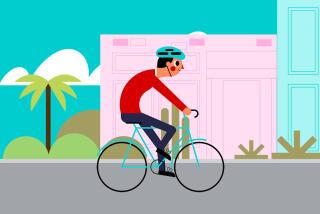World-Class Bicycle Club Brakes for L.A. : Journey: Six disabled riders arrive for final segment of their around the globe odyssey.
- Share via
They’re an unlikely group to have pedaled around the world on bicycles.
But the half a dozen cyclists who slowly maneuvered off an airplane Thursday in wheelchairs and on crutches were peddling something more: hope for others with disabilities.
Members of World Ride ’95 arrived in Los Angeles from Japan to start the final segment of an eight-month, 13,000-mile odyssey that will end in mid-November in Washington.
Throughout the trip, hundreds of other disabled riders have joined in for weeks at a time, traveling alongside the six over freezing European mountain passes and across muddy Siberian steppes.
The journey has been marked by tears of joy. And of pain.
“People have been crying as they’ve come up to give us hugs and kisses,” said 37-year-old Agnes Kearon, a one-armed Saratoga Springs, N.Y., woman who rides a bicycle she has rigged with brakes and gears that can be operated by her right hand.
Cyclist David Cornelsen, 43, of Huntington Beach uses both hands to pedal his specially designed, three-wheeled bicycle. He is paralyzed from the knees down because of a 1987 car crash.
Cornelsen said the trip’s worst moment--”the one burned in my mind”--occurred the day riders left Dresden, Germany, and climbed a 3,500-foot mountain in a freezing rainstorm. Once at the top, they ended up careening down the other side.
“I was soaked and cold. I was shaking so violently that all my muscles were tightened on me,” he said. “Then we came down and our brakes melted. I couldn’t stop at the bottom--I had to grab onto a passing van to slow myself down before I could stop.”
The $4-million bike ride is being primarily financed by corporate sponsors. Organizers recruited non-disabled support team workers to accompany the cyclists and arranged for the other handicapped riders to join in.
One was a 24-year-old UCLA law student, Cara Dunne, who covered about 1,000 miles across Siberia, riding tandem with trip planner Steve Whisnant of Charlotte, N.C. Dunne lost her eyesight to retinal cancer at age 5.
“I’d describe the landscape, the clusters of birch trees and men on horses tending cattle,” Whisnant recalled. “I’d describe military complexes when we went past them and we’d talk about what it must have been like during the Cold War.”
Siberia was a challenge for riders--who were assigned former Soviet KGB “Alpha Force” officers as bodyguards during part of the trip. At one point, a Russian interpreter crashed one of their support vehicles and destroyed several backup bikes.
Mongolia’s Gobi Desert was no picnic either, according to rider Steve Ackerman, a 41-year-old Ft. Collins, Colo. resident paralyzed from the hips down since a 1987 car wreck.
“There was 600 miles of road-less terrain. You just picked a set of tire tracks in the ground and followed them,” Ackerman said. “It went on for days and days.”
But crowds materialized in every hamlet that riders passed through. Villagers were usually astonished to discover that the visitors were disabled. Often, they were given demonstration rides on the bicycles.
“You’d see someone with a disability along the road and it would be clear they hadn’t before seen that there are opportunities out there for them,” said rider Rory McCarthy--a 41-year-old Bath, Me., electrician who walks with the aid of crutches because of muscular atrophy.
The riders are scheduled to be honored today by Los Angeles City Council members.
More to Read
Sign up for Essential California
The most important California stories and recommendations in your inbox every morning.
You may occasionally receive promotional content from the Los Angeles Times.














